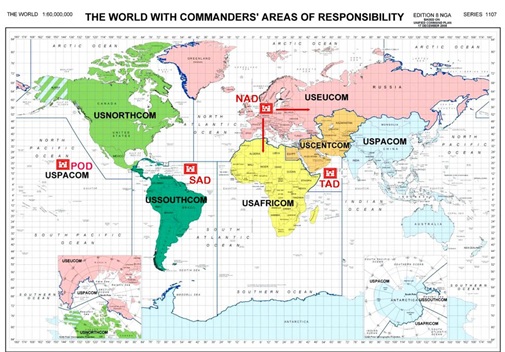The Fraud of Endless War
 There is not a single war or serious military confrontation since WWII involving the U.S. that needed to be fought. Every conflict where soldiers and civilians suffered death or injury was — and is in the case of the ongoing fighting — unnecessary. These battles for territory, control, resources, subjugation, spite, are the direct result of greed, hubris, racist arrogance, ideological fanaticism, sometimes just pure ego. Predictably, we hear high sounding rhetoric in every instance about spreading democracy, safeguarding freedom, responsibility to protect, defending our national interests, rules-based international order, yakkety yak blah blah blah. It’s all just spin to manufacture acquiescence and consent, to get us sheeple to stand down and let the warmongers and empire builders, the MIC and the war industry, have their way.
There is not a single war or serious military confrontation since WWII involving the U.S. that needed to be fought. Every conflict where soldiers and civilians suffered death or injury was — and is in the case of the ongoing fighting — unnecessary. These battles for territory, control, resources, subjugation, spite, are the direct result of greed, hubris, racist arrogance, ideological fanaticism, sometimes just pure ego. Predictably, we hear high sounding rhetoric in every instance about spreading democracy, safeguarding freedom, responsibility to protect, defending our national interests, rules-based international order, yakkety yak blah blah blah. It’s all just spin to manufacture acquiescence and consent, to get us sheeple to stand down and let the warmongers and empire builders, the MIC and the war industry, have their way.
Those in the peace movement know the specific details rendered with this next graphic well. People who are preoccupied with living life and overcoming its many obstacles might dismiss it as fake news. But very tragically, it’s entirely factual. The U.S. just can’t stop attacking others.
 There are three fundamental reasons why the U.S. is a belligerent, bullying aggressor, or as Martin Luther King, Jr. famously summed it up, “The greatest purveyor of violence in the world: my own government.”
There are three fundamental reasons why the U.S. is a belligerent, bullying aggressor, or as Martin Luther King, Jr. famously summed it up, “The greatest purveyor of violence in the world: my own government.”
Thus there are three reasons we are perpetually at war. These are …
Ideological Drivers of Endless War
There has never been a shortage in recorded history of master race ideologies. We find them even enshrined in religious texts. The U.S. has its share of such doctrinal canons, each couched in marvelous language and noble-sounding rhetoric, promoted by a host of noted individuals and organizations, e.g. Paul Wolfowitz, Zbigniew Brzezinski, Council on Foreign Relations, Project for the New American Century, all anointing the U.S. as the indispensable nation, the world’s rightful heir as the master overlord. There is no ambiguity or nuance here. America has formally declared itself as the supreme authority over the entire planet. The latest buzz phrase is “rules-based order”, which effectively means the U.S. will make the rules to establish the order in the world, everyone else will obey or face the consequences. Those consequences take the form of economic or military terrorism, buttressed by the U.S. dollar as the world reserve currency and the awesome might of the largest military in the history of the world.
Social and Political Control Drivers of Endless War
Defending the homeland and war command our attention. They focus our energy, steel our resolve, unify us, add purpose and drama to otherwise mundane day-to-day life. They play on our most basic instincts for survival and protection of what’s dear to us. But on the flip side, they also shut down critical faculties, create a visceral bond with the worst aspects of human nature, and open the door for tyrannical control and elimination of basic freedoms and rights. War unites us alright — in fear, suffering, misery, deprivation, shame, anger, suspicion, hate, paranoia, dehumanization and death.
Economic Drivers of Endless War
There are huge fortunes to be made with war. Conquered nations can be plundered. At home, those who invest in war industries will see magnificent returns. The more war, the greater the profits. It’s no secret that military conflict is encouraged, in fact driven, by profiteers on Wall Street and from within the defense contractors themselves. There’s a rotating door between those who head up defense companies and those who sit at the seats of power shaping policy and making the decisions which countries will be demonized, intimidated and attacked. Our current economic/political model incentivizes an unruly, aggressive, confrontational foreign policy and generously rewards the creation of war zones and arenas of conflict.
It is often said that the U.S. cannot be without an enemy. This is only partially accurate. More to the point, it is the military-industrial complex that can’t be without an enemy. NATO’s massive bureaucracy and whole reason for existing cannot be without an enemy. What’s the point of the enormously bloated U.S. military, with its 800+ overseas bases, its vast fleets of battle ships and submarines, its vast array of military satellites and surveillance centers, its psyops and special ops and secret ops, its carving up the entire world into combatant command zones if there isn’t an enemy? Here’s how the U.S. sees the world.
Let’s bear in mind what all of this means by looking at the big picture.

The entire Imperial Project — world rule by the U.S. as a self-declared hegemon — is at its core and at every layer anti-democratic. It replaces self-determination in the countries we dominate with our authoritarian control — a polite phrase for totalitarian subjugation — making it ironic and odiously cynical that the U.S. claims to spread democracy in the world, when it regularly overthrows democratically-elected governments, then replaces them with despots which do our bidding.
Just as tragically, the decision to be an empire, the entire program of global domination, mocks the idea of democracy in America itself. It was conceived of and initiated by a tiny minority of power-drunk, monomaniacal, avaricious psychopaths, supported by a ruling elite which sees conquest and plunder as just another day at the office. Put simply and directly: We as citizens never voted for any of this. And if we understood the true nature and agenda of the Imperial Project, we would without hesitation or equivocation entirely reject it and the misery and impoverishment it ultimately entails, both domestically and overseas.
Right here at home, the Imperial Project by forcing its agenda on U.S. citizens, obliging us to underwrite it every single day of our lives with in-kind and out-of-pocket cash payments of our hard-earned dollars, coupled with the loss of freedom and opportunity, a complete silencing of the voice and priorities of everyday citizens, is at its core and at every layer anti-democratic, despotic, and exploitative. We as citizens have become an ATM machine for the warmongering lunatics trouncing other countries across the globe. We are indentured slaves to a militarized economy which requires war to function, frightened subjects of a regime that creates enemies everywhere, pawns of a power game and calculated strategy to set us against one another, a social-political climate intentionally engineered to maintain “total spectrum domination”, meaning totalitarian control even within our own borders.
Maybe the idea of a benevolent, enlightened, inspired and visionary U.S. leading the world into a new age of affluence and harmony, guided by the best principles of democracy and driven by shared humanitarian values seems appealing. But it’s an illusion. It’s an illusion fostered by massive deceptions, propaganda, brainwashing, engineered for our compliance and complicity in the madness that has overtaken our governing institutions. Read the speeches of the mentors for this type of hyper-nationalistic insanity, the architects of the Third Reich, and see how closely they align with the promises of our current batch of make-America-great-again demagogues. Creepily, ‘Aryan super race’ and ‘American exceptionalism’ are bedfellows, the spawn of the same lunatic delusions. ‘Indispensable’ is nothing but code for ‘1000 year Reich’.
Yes, that avuncular icon at the top, embraced, lauded, and emulated by the patronizers of a naive, trusting and gullible citizenry, is pointing at us, you and I, entreating us to be a part of a sinister plan to take over the world.
We better make the right choice … while we still can make a choice.
Time is running out.






